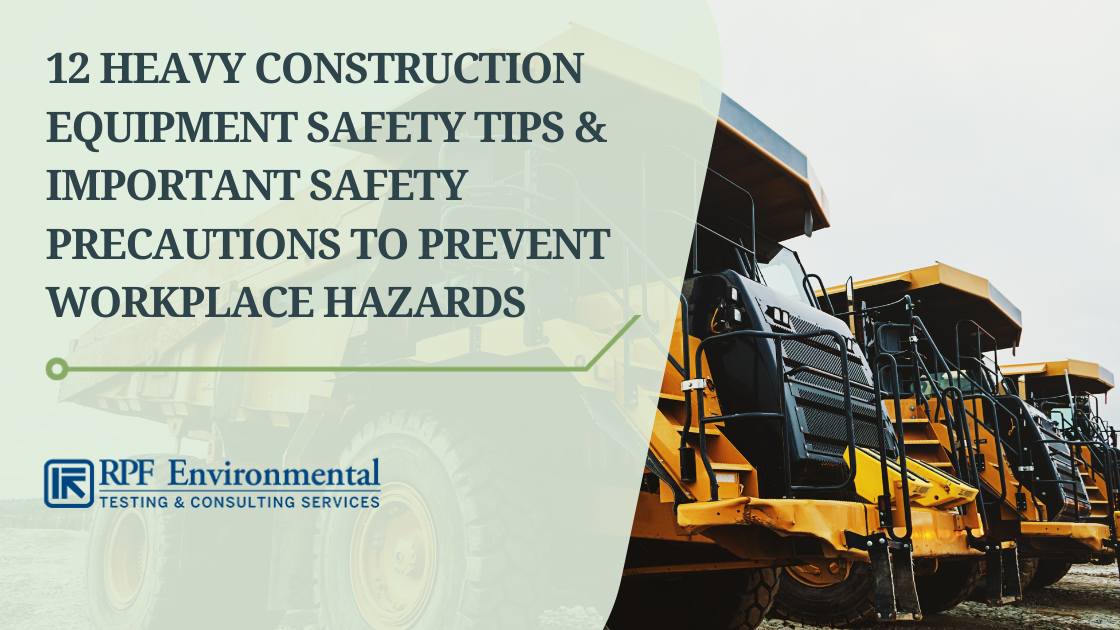Prevent heavy equipment accidents and fatalities involving construction operators, employees working around heavy equipment, and pedestrians through these safe work practices.
With numerous hazards in construction sites, improper heavy equipment operation can cause accidents and deaths that can lead to costly OSHA violations, project delays, and worker compensations. By following these top heavy construction equipment safety tips and precautions, you can keep your business running and avoid liabilities.

Train your employees on the best workplace practices and stay compliant with OSHA regulations through our certified EH&S training programs and OSHA consulting services. We serve Maine, Massachusetts, New Hampshire, and across the country. Book a consultation now!
Pre-Operation Heavy Equipment Safety Tips to Prevent Accidents: What Should You Do Before Operating Any Piece of Equipment?
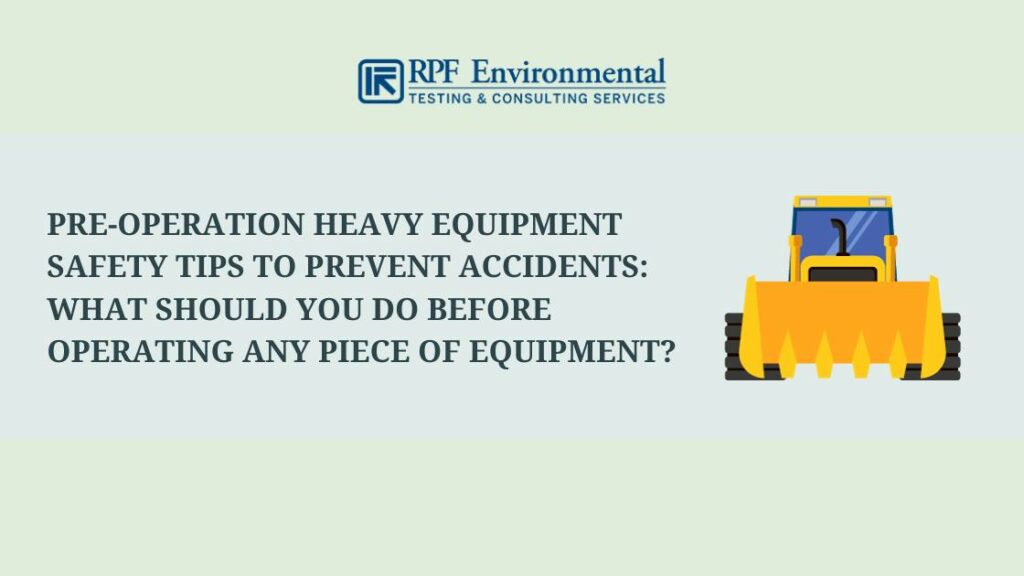
#1. Operators Should Undergo Proper Construction Equipment Safety Training
Heavy equipment operators should receive proper and adequate training regarding safe work practices and techniques in operating heavy construction equipment to ensure safety. Training programs are usually equipment-specific (cranes, loaders, excavators, forklifts, bulldozers, etc.) and include practical hands-on training. Only workers who have been trained and/or certified to use specific types of equipment should operate them.
In addition, heavy equipment operator training courses may include the following:
- Personal Protective Equipment training
- Safe equipment operation & maintenance (familiarity with the equipment’s operator manual)
- Hazard identification
- Proper loading and unloading
- Machine guarding, etc.
It is also important for operators to understand machine safeguarding and know the limits of the equipment they are using to prevent creating hazards.
Also Read: 11 Types of Safety Training for Construction Workers
#2. Use the Right Type of Heavy Equipment That Is Suitable for the Job
Equipment selection plays a major role in minimizing risks in the workplace. They should be well-designed and include a fail-safe mechanism along with other safety controls to prevent accidents during malfunctions. In addition, heavy equipment should only be used for its intended purpose as per the manufacturer’s recommendations. Otherwise, operators might end up damaging the equipment which can lead to injuries or fatalities.
#3. Inspect the Workplace for Hazards
Perform daily walk-around inspections for underground hazards and overhead obstructions before work starts. Check for the following and take necessary actions such as setting up barriers and fencing:
- Cables and wires
- Power lines
- Low clearance
- Gas lines
- Trenches
- Dugout holes
Moreover, distractions should also be fixed and ensure that operators have a clear visual path. Minimize blind spots by using mirrors and other safety devices to improve visibility. Remove trip and fall hazards, make sure that there is enough space to allow for maneuverability, provide adequate lighting, and inform affected individuals regarding equipment hazards. It is also best to put up warning signs and safety notices as well as provide training not only to operators but also to affected employees.
#4. Inspect & Test the Equipment Before Use
Ensure that every equipment is in good condition and safe to operate through pre-use inspection. We highly recommend using a heavy equipment inspection checklist for this to make sure that all potential risks are identified.
Your checklist may include checking for:
- Seatbelt
- Leaks
- Fluids
- Oil
- Undercarriage
- Engine
- Lights
- Gauges
- Tires
- Valves
- Steering components
- Fuel system
- Exhaust system
- Cooling system
- Belts
- Hoses
- Brakes
- Battery
- Fan & fan belts
- Safety mechanisms
- etc.
Any malfunctions or defects identified during the inspection should be reported to the supervisor or maintenance team. In addition, faulty equipment should be repaired and tested before use.
Tip: Perform routine maintenance to ensure that every equipment is in good condition. Also, equipment risk assessment helps in identifying potential hazards and eliminating risks before use.
#5. Install Proper & Adequate Safeguards
OSHA requires any part, process, or function of machines that can cause severe workplace injuries (e.g. amputations, crushed fingers, blindness, and burns) to be safeguarded.
Employers are responsible for ensuring the safety of operators and employees working on or around heavy equipment. One way to do this is by installing appropriate and adequate safeguards on every piece of equipment to avoid machine-guarding accidents.
Also Read:
- Types of Machine Safeguarding: Understanding Your Machine’s Safeguarding Needs
- OSHA Requirements for Machine Guarding: Industry Standards for Machine Safety Systems
RPF Environmental offers professional machine guarding and safety services to help you with this. Thus, ensuring your compliance with applicable machine safeguarding rules and regulations in addition to workplace safety.
Other important tips to note are:
- Don’t use unauthorized safeguards
- Don’t use equipment with damaged safeguards
- Never attempt to remove or bypass safeguards
- Operators should know how to use safeguards and know what to do in case of missing, damaged, or inadequate safeguards (reporting to the supervisor)
NOTE: Machine safeguarding violations are among the top OSHA violations regarding workplace safety that can lead to costly penalties.
#6. Operators Should Always Wear Seatbelts
Seatbelts save lives.
Providing seatbelts on dangerous equipment is another method that employers can do to protect their employees from serious hazards. It is also a requirement under OSHA 29 CFR 1926.602 where failure to comply can lead to citations.
Heavy equipment operators must always wear a seatbelt to keep them from accidentally being thrown from or falling off the machine in case of rollovers or tip-overs. Failure to wear seatbelts has caused many fatal rollover incidents, especially in construction sites, and can put pedestrians and other workers around in danger.
#7. Wear the Right Personal Protective Equipment (PPE)
Aside from seatbelts, operators must wear the required protective gear that is appropriate for the type of equipment they’re using to avoid exposing themselves to dangers. This often includes:
- Gloves
- Hard hats
- Helmets
- Goggles
- Safety glasses
- Face shields
- Ear plugs or muffs
- Back gear
- Safety shoes
- Long-sleeve shirts
- Long pants
- High-visibility clothing
In addition, avoid dangling jewelry, loose clothing, and long hair to avoid creating nip hazards.
Also Read:
- 7 Types of Personal Protective Equipment (PPE) for Construction to Ensure Job Site Safety
- Effective PPE Selection & Hazard Assessment: 6 Factors to Consider When Choosing Workplace-Specific PPE
#8. Don’t Operate Any Equipment When You Feel Incapable of Doing It
Lastly, operators should make sure that they are emotionally, mentally, and physically capable before operating the equipment. They should remain alert, ensure that they have understood instructions clearly, and be in their best emotional/mental state to avoid fatalities and injuries due to poor judgment calls.
Heavy Construction Equipment Safety Tips During Operation: What Should You Do if You Are Operating Heavy Equipment
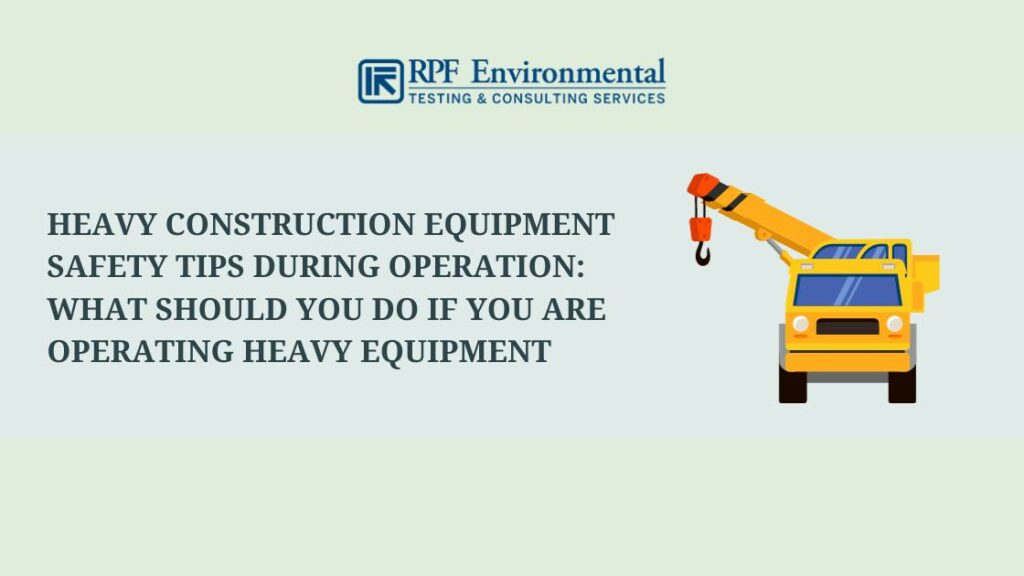
#9. Keep Blind Spots Clear & Get a Spotter
Operators should know where blind spots are and maintain adequate clearance distances around other objects. They should ensure that they have a clear line of sight around the equipment and that no one is in the blind spots before moving. If unsure of the surroundings, they should get out of the equipment to check.
In addition, getting a spotter trained in construction hand signals can improve worker visibility and help prevent the equipment from moving into dangerous positions and construction zones.
#10. Maintain Effective Communication
Aside from spotters, ongoing communication with supervisors and other people around the work area using two-way radios also helps compensate for blind spots. More importantly, you should develop effective communication protocols to enhance workplace safety.
#11. Load and Unload Properly & Watch Load Limits
Improperly loaded and insecure loads as well as overloading can cause the equipment to tip over or loads to fall which can endanger pedestrians. Always consider stability when loading and ensure that loads are properly secured and centered.
Start with the heaviest loads when tiering, level the forks, and only load/unload on level ground to prevent rollovers and tip-overs. In addition, operators should not exceed the equipment’s weight capacity. Use spotters to help ensure that the area is clear before unloading in high-traffic areas.
Also Read: Common Forklift Risks & Safety Tips: How Can You Decrease the Likelihood of Injuries While Using Forklifts?
#12. Follow the Three-Point Rule When Mounting and Dismounting
Always maintain three points of contact with the equipment when climbing on and off to avoid falls, missteps, or even death. You can either use two feet and one hand or two hands and one foot to maximize stability. Never jump off the equipment. Ensure that you have a firm grip on handles or rails and use steps.
Staying Safe Around Heavy Equipment: What Are the Safety Tips When Working Around Heavy Equipment?
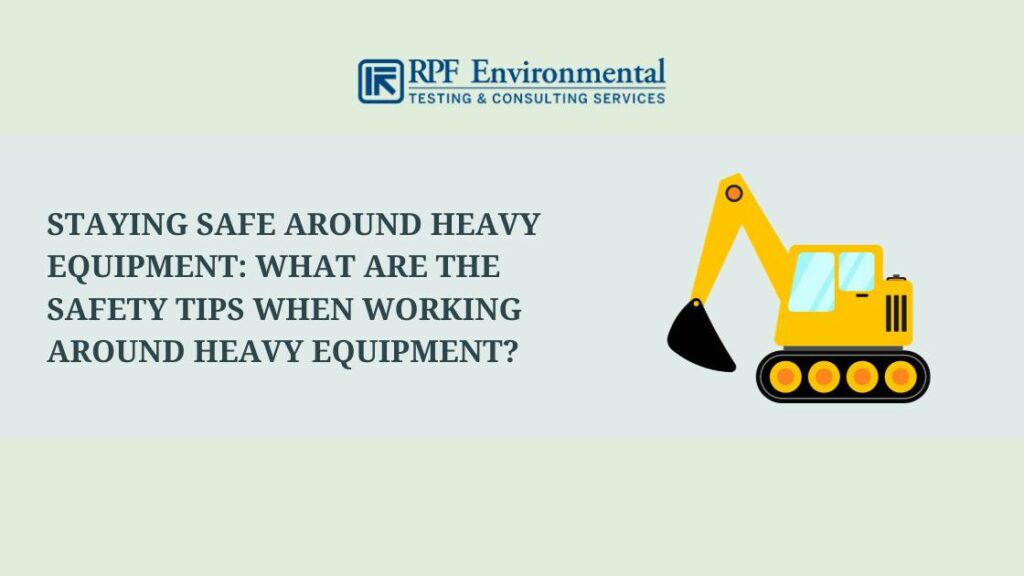
Aside from operators, other employees working on or around heavy equipment should follow these safety precautions to avoid putting themselves in danger (e.g. avoid being struck by heavy equipment):
- Implement proper lockout/tagout (LOTO) procedures to control hazardous energy and prevent unexpected start-up before any maintenance or servicing tasks.
- Choose the right LOTO devices that are authorized for the equipment. Only trained and authorized employees should only apply LOTO devices.
- Reassemble machine guards and safety devices after equipment maintenance.
- Avoid walking or standing under suspended loads.
- Maintain a safe distance from heavy equipment that is in use. Stay away from moving parts.
- Avoid distracting operators.
- Wear high-visibility clothing.
- Make sure that operators can see you when approaching the equipment. Avoid being in blind spots.
- Do not ride on moving equipment.
Other Important Things to Know About Heavy Equipment Safety
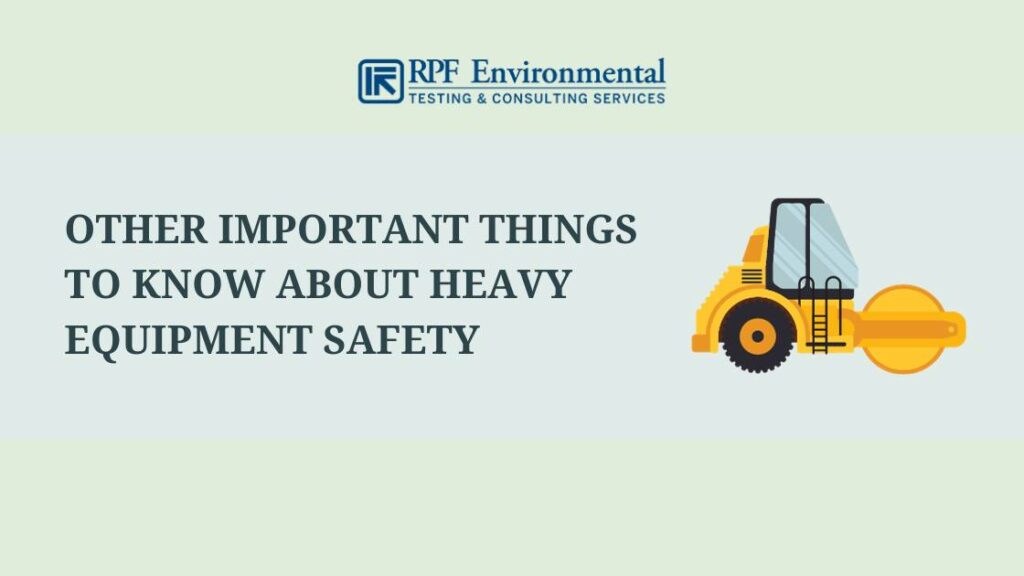
4 Common Heavy Equipment Hazards
The top construction hazards when working with or around heavy equipment include the following:
#1. Falls
Falls are the leading causes of death in the construction industry followed by struck-by incidents, electrocutions, and caught-in/between incidents. Working on elevated platforms
#2.Struck-By Incidents
These are usually caused by not wearing high-visibility clothes near heavy equipment or positioning oneself between fixed and moving objects.
#3. Caught-in/Between Hazards
Unguarded moving parts of an equipment that is in use can pull body parts or clothing into it which can lead to more serious consequences. Workers can also get caught between moving vehicles and solid objects and get crushed. These can be avoided by installing adequate machine safeguards and implementing effective LOTO procedures.
#4. Electrocutions
Not controlling hazardous energy through a LOTO procedure and failure to shut off power sources properly during maintenance procedures can lead to electrocutions.
Why Is Safety Training Important in Construction?
The main purpose of employee safety training in construction is to keep employees safe by providing them with the right skills and knowledge required to safely operate heavy equipment. They will be able to:
- Recognize hazards and know how to effectively prevent them to avoid accidents and fatalities
- Choose the right PPE and use them properly
- Respond to emergency situations promptly
In addition, providing safety training avoids penalties and violations that can damage the business.
Also Read:
- Understanding Confined Spaces for Workplace Health & Safety: Definition, Standards, & Training
- Acceptable Noise Level: At What Decibel Is Hearing Protection Required?
FAQs
The top heavy equipment hazards include falls, struck-by incidents, caught-in/between hazards, and electrocutions. These can be prevented through proper employee training, installing adequate safeguards, and implementing lockout/tagout procedures.
Safety precautions are necessary when using heavy equipment to prevent accidents, deaths, costly worker compensations and violations, and damage to your business.
The most important safety precautions when using large equipment include:
– Choosing the right type of equipment for the job
– Pre-operation workplace and equipment inspections
– Wearing appropriate PPE
– Avoiding blind spots
– Loading and unloading safely
– Maintaining effective communication
Establishing an energy control program to develop an effective Lockout/Tagout procedure ensures the proper isolation of energy sources before maintaining or servicing machinery. Thus, protecting workers from workplace hazards including electrocution, fractures, or death.
Conclusion
Heavy equipment safety starts with eliminating or minimizing hazards before they can lead to costly consequences. Performing workplace and equipment inspections prior to equipment use helps identify and address potential risks. Installing safeguards, wearing the right PPE, and following other safety practices can significantly reduce heavy equipment-related accidents.
RPF Environmental can help you maximize workplace safety through our EH&S training programs as well as comply with OSHA regulations through our OSHA compliance consulting services. We serve businesses nationwide. Contact us now!

